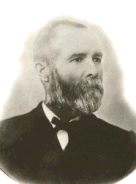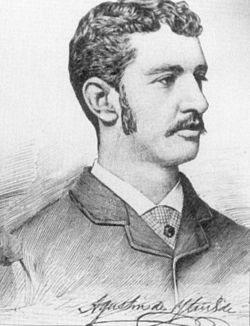History
Early settlers
The first settlers to cross into Mexico from the United States were traders and fur trappers. This included settlements in the northern territories of Alta California, Santa Fe de Nuevo México and Mexican Texas. The first empresarial grant in Texas had been made under Spanish control to Stephen F. Austin, whose settlers, known as the Old Three Hundred, settled along the Brazos River in 1822. The grant was later ratified by the Mexican government. Twenty-three other empresarios brought settlers to the state, the majority from the United States. In 1824, Mexico enacted the General Colonization Law, which enabled all heads of household, regardless of race or immigrant status, to claim land in Mexico. Due to a large number of unassimilated American settlers and imported slaves, President Anastasio Bustamante outlawed further immigration of United States citizens to Texas through the Law of April 6, 1830, nonetheless immigration continued illegally.
Mexico once recognized citizens born in the territory lost in the Treaty of Guadalupe Hidalgo to protect their property, farms, and ranches. However, they had to adopt a new nationality and very few descendants had ever decided to regain their Mexican nationality.
Post Mexican-American War

Facing the threat of enslavement, in 1850 the Black Seminole leader John Horse and about 180 Black Seminoles staged a mass escape to northern Mexico, where slavery had been abolished more than twenty years earlier. There is a band of the Kickapoo tribe present in northern Mexico as result of 19th-century migration. There is also a Cherokee Nation of Mexico that claims to be the descendants of 19th-century Cherokee migrants. However, they are not officially recognized by the Federal government.
A few of the routes of the Underground Railroad led to Mexico. [3] An estimated 5,000 to 10,000 slaves escaped to Mexico. [4]
In 1865 a substantial number of former Confederates fled to Mexico from the defeated Confederate States of America. [5] [6] [7] They set up the New Virginia Colony. However, many of the ex-Confederates left the country once Emperor Maximilian I was overthrown.
Businessmen and settlers in the Porfiriato
During the Porfiriato, foreign businessmen were welcomed into the country in order to help with Mexico's modernization through enterprises such as railroad construction and mineral exploitation. American capitalists included the likes of Edward L. Doheny and William Cornell Greene. Also notable among these early entrepreneurs were the Californian immigrants Walter and Frank Sanborn, who opened Mexico's first soda fountain. Their business would go on to become the Grupo Sanborns.
Founded in 1888, the American School Foundation in Mexico City was created to cater to the American immigrants of the city.
In an attempt to settle and industrialize rural areas, particularly the sparsely populated northern states, the Porfirian government encouraged organized settlements by Mexicans and foreigners. American endeavors included Los Mochis in Sinaloa, originally a utopian colony; Colonia Chamal in Tamaulipas, mostly farmers from Oklahoma; [8] and Colonia Díaz in Chihuahua, the first Mormon colony.
A notable example of a businessman founding an American immigrant colony is William H. Ellis. He established a worker settlement in Tlahualilo, Durango for black Americans seeking to escape the Jim Crow South, however the settlement failed and most settlers returned to the United States.
A prominent Mexican of U.S. ancestry is former president Vicente Fox, whose paternal grandfather, Joseph Louis Fox, [9] was born in Cincinnati, Ohio and emigrated to Mexico in 1897.
20th century artists and leftists
For decades, Mexico has also drawn numerous artists, including painter Pablo O'Higgins, who participated in Mexico's muralism movement, silversmith William Spratling, who helped revitalize the silver industry in Taxco, and dancer Waldeen Falkenstein, who was influential in the teaching of modern Mexican dance. Opening in 1950, the Instituto Allende drew American art students to San Miguel de Allende and helped make the town an important destination for American emigrants.
During the Cold War, Mexico was a country of refuge for political leftists, and received various American exiles, notably from the film industry. An example was Elizabeth Catlett, prominent African-American artist who was declared an "undesirable alien" by the US government as a result of suspected Communist affiliations.
Recent immigrants
Recent migrants can be classified into three broad categories: retirees (who tend to settle in American enclaves like Ajijic or San Miguel de Allende), professionals working in Mexico (tending to reside in large cities like Monterrey or Mexico City) and the Mexican children born in America (who can be found throughout the country). These American-born minors generally follow their parents once they are deported to Mexico. Nonetheless, it is also common for adult children to return to their parents' home country of their own will.
From 2014 to 2016, 23,613 Americans received permanent residency, with a total of 72,140 Americans receiving temporary or permanent residency permits. [10] About 600,000 US-born children live in Mexico. [11] According to 2015 data from the National Institute of Statistics and Geography (INEGI), more than 280,000 children born in the US and now living in Mexico, do not have sufficient documentation to prove their Mexican identity. [12]
In the 2020s, Americans taking advantage of remote work programs have contributed to the gentrification of Mexico City. [13]
In November 2022, the U.S. Social Security Administration paid more than 62,000 individuals in Mexico, the third largest group of beneficiaries after those in Canada and Japan. [14]






